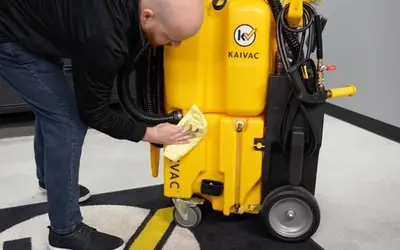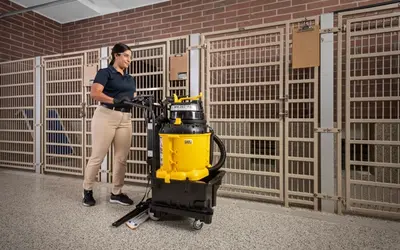QSRs Save Time, Money, and Headaches with UniVac

We’re always talking about how Kaivac equipment saves restaurant owners time, money, and effort. And this isn’t just talk. Our Return on Investment (ROI) calculator, developed by food service director MarcFerguson, shows exactly how we get those big, beautiful numbers. Ferguson partnered with owners and managers of several different Quick Service Restaurants (QSRs) to document their floor cleaning process. All of them were franchises of major national chains. Restaurant representatives reviewed and verified all data.
Initial data included how much resource – labor, chemical, and consumables – goes into working with mops, brushes, and buckets. Then Ferguson compared those numbers to cleaning floors with the battery operated UniVac.
The results are astounding. The UniVac outperforms mops, buckets, and brushes on every metric. The enthusiastic QSR managers also report better grease removal, faster spill recovery, and happier team members.
Before we dive into the results, there are a few important points to note. The data in this blog are specific to individual locations but easily extrapolate to any Quick Service Restaurant. Ferguson’s calculations include:
- The QSR’s yearly hours of operation
- Local labor rates, ranging from $12 to $13 per hour
- Floor cleaning jobs broken down by front of house, counter, and back of house
Here’s a breakdown of all the proven ways UniVac saves QSRs time, money, and effort.
QSRs Slash Cleaning Time by 75% with UniVac
Three QSRs in this trial specialize in fried chicken. Ferguson worked with them to track the hours team members spent cleaning floors with traditional tools. He then logged the team’s cleaning time using the UniVac.
The results show dramatic savings. One busy location went from spending a total of 250 labor minutes a day on floors to just 60. A different location that required 170 minutes now gets the job done in a slim 43 minutes with the UniVac.
And if you’re thinking that your team members only spend a half hour cleaning floors, well, Ferguson suggests asking some hard questions about the quality of that clean. Are floors tacky and greasy? Do they smell bad? Are there food scraps moldering under equipment and attracting vermin?
“The UniVac actually removes grease, dirt, and dropped food from the floors,” says Ferguson. “Mops move grease around. They push food scraps behind equipment or into the service drain to clog it. Floors end up looking terrible and smelling worse.”
UniVac Saves One QSR Over $17,000 a Year in Labor Costs
Saving time translates into lower labor costs. For proof, Ferguson examined one franchise, this one part of a premium national chicken chain, and found that it takes 370 minutes total to clean floors using mops, buckets, and high-low brushes every day. That work is divided between 10 team members who each spend between 15 and 45 minutes per day cleaning a designated station or area of the restaurant. The restaurant is open 312 days a year. With a labor rate of $13 an hour, floor cleaning labor costs add up to a whopping $25,000 annually.
Introducing the UniVac tamed those costs. Now a four-person team only needs about 30 minutes each, or a total of 118 minutes, to fully clean those same floors. At an annual cost of just under $8,000, labor savings total a dramatic $17,000.
“They used to need four team members just to clean the back of house floors,” said Ferguson. “With the UniVac they only need one. The other three employees can clock out and go home.”
Stop Spending Over $1,000 a Year on Mops
UniVac savings don’t stop with time and labor. QSRs also use an extraordinary number of consumables like mop heads, hi-low brushes, and squeegees. One restaurant spent a whopping $1,000 a year buying mop heads alone.
They may be an outlier, but other QSRs Ferguson studied still spent too much, between $96 to over $500 a year, on the same technology that does not work. He found that trading them for UniVac consumables is a smarter, money-saving move.
“Every QSR I analyzed saved at least $1,000 a year on consumables. One saved over $1,700,” he says.
Bonus benefit: Some QSRs spend even more money, up to $4,800 a year, outsourcing carpet care. A $34 carpet care attachment for the UniVac eliminated the need for that expensive service.
Employees Love the UniVac
These numbers are impactful enough, but QSRs also report that the UniVac helps boost employee satisfaction which could help with employee retention.
“One manager told me she buys the UniVac because her team members love using it,” says Ferguson. It’s a story he hears a lot.
Another manager at a restaurant famous for burgers and fries told Ferguson that team members race to use the battery powered UniVac.
“Nobody wants to get stuck using the mop,” he reports.
Employee satisfaction applies to managers as well. After using the UniVac, one manager remarked that the glossy, greasy residue that once marred the front of house floor disappeared.
“She noticed because she could now see her own greasy footprints tracked from the kitchen,” says Ferguson. “The more they used the UniVac in the back of house, the better they got at controlling grease throughout the space.”
Related Posts

Preventive Maintenance for Your No-Touch Cleaning® System
Your Kaivac No-Touch Cleaning system makes restroom maintenance fast and easy. Keeping your No-Touch Cleaning system in good working order is also fast and easy. Kaivac makes performing preventative maintenance and troubleshooting potential issues simple. No special equipment or technical expertise required.
Read more
The Best Dog Kennel Cleaning Equipment
There are ways to simplify the kennel cleaning process. Automatic kennel cleaning equipment can simplify the kennel cleaning process and can save hours of daily, back breaking labor–even for facilities without central drains.
Read more
A Better Retail Floor Care Option: How One National Retailer Reclaimed Floor Care
Discover how a national retailer cut costs and improved results by switching to Kaivac’s All Floor™ system—an easy, all-in-one floor care solution perfect for low-revenue retail locations.
Read more